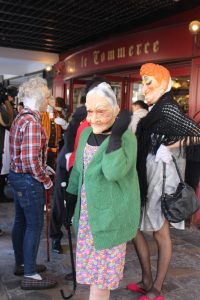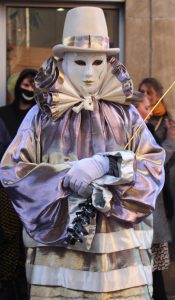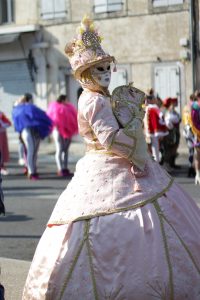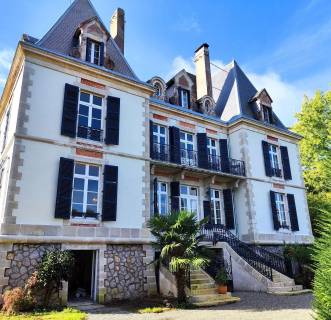Aug 042023
 A 400-year-old tradition, 3 months of celebration, music, dance and blanquette! Discover an unforgettable atmosphere of the world’s longest carnival in Limoux!
A 400-year-old tradition, 3 months of celebration, music, dance and blanquette! Discover an unforgettable atmosphere of the world’s longest carnival in Limoux!
The longest carnival in the world
When you are visiting Limoux for the first time, between January and March, you may think that they have some big weddings here! Tons of confetti cover all the town’s square (Place de la République) and the surrounding streets. But this is the part of The Limoux Carnival, renowned as one of the oldest in the world, and certainly the longest.
From January to March, every Saturday and Sunday and Pancake Tuesday, the “Fecos” and “Goudils”, accompanied by traditional music, dance from one café to another on the Place de la République, throwing confetti at the spectators and waving their reeds called carabene.
After three months of festivities, the carnival ends with the Nuit de la Blanquette. Blanquette being the city’s emblematic drink.
Carnival dance and music
 After having a filling breakfast, the bands put their costumes on. It is a long day for them as they are performing three times at 11:00 am, 4:30 pm, and 10:00 pm.
After having a filling breakfast, the bands put their costumes on. It is a long day for them as they are performing three times at 11:00 am, 4:30 pm, and 10:00 pm.
For the morning performance, each band chooses a theme for the costumes, that could be related to the news or a particular event. It could be the presidential election or some embarrassing scandal concerning local authorities!
The masked dancers dance to the music provided by the band of about 15 musicians. The instruments used usually include trumpet, clarinet, baritone, slide trombone, bass, double bass, bass drum, snare drum and helicon. Every year you can hear exactly same tunes that vary depending on the day time.
The masked dancers dance solo with their arms raised, with the movements of the hand emphasizing the melody. The carabene (the reed), an extension of the hand, plays a special role in all gestures. The free hand, like the other, must always be held above the shoulders.
It all makes the carnival a very unique and gives it its special, mysterious character.
The accessories of the Carnival
 The accessories that match the theme of the costume for the Goudils (e.g. toilet brush for the cleaner, crystal ball for the future teller, etc.).
The accessories that match the theme of the costume for the Goudils (e.g. toilet brush for the cleaner, crystal ball for the future teller, etc.).
The confetti satchel is essential for the the Pierrots, so they can throw the confetti at the spectators.
The carabene: decorated and wrapped reed, flexible enough to follow the turns of the music, which also is used, by tapping the head of an onlooker, to indicate to him that he is known. It is also the crucial requisite of the Pierrot dancer.
The mask can be fabric, latex or plastic. It is painted with the colours that are matching the costume and are different to each band.
The hood to hide the hair, ears and neck.
Gloves are another, important part of the dancers outfits.
Costumes of the Carnaval de Limoux
 Pierrot:
Pierrot:
The “Pierrot” costume is a very typical outfit for the dancers of the carnival. The costumes are different for each band. Usually the costume includes a mask that should keep a person identity a secret, a hat, satin top with buttons, satin trousers, ruff collar and gloves.
Pierrot, a French pantomime character is inspired by the Italian Commedia dell’Arte. They are called Las Fécos in the Occitan language.
The Goudil:
These are the dancers that don’t belong to the band and stay behind the musicians, wearing the most crazy costumes including toilet seats covered with chocolate (hopefully!). The funnier the costume is, the better it is. Everyone can dress up as a goudil and take part in the celebration.
The Miller:
Dressed in a white outfit, the miller of Limoux wears wooden clogs and a white nightcap with a pompom. The accessory is a whip. He comes out on the first Sunday of carnival to evoke the tradition: he goes to the authorities to obtain the permission to start the carnival.
Carnaval du Monde
 Carnival of the World (Carnaval du Monde) is a spectacular and vibrant part of the celebration. You don’t have to go to Brazil to see half naked, beautiful ladies dancing samba!
Carnival of the World (Carnaval du Monde) is a spectacular and vibrant part of the celebration. You don’t have to go to Brazil to see half naked, beautiful ladies dancing samba!
During the last Carnival of Limoux 2023 more than 300 dancers and many musicians from all over the world came to join the party.
Spectators could admire fabulous and colorful costumes from countries like Ecuador, Portugal, Spain, and Brazil.
There was also a presentation of Venetian masks and costumes.
Nuit de la Blanquette
The end of the carnival takes place during the night of the blanquette de Limoux . On this occasion, the Fécos (people in masks) and the public are singing the song Adiu paure Carnaval.
After three months of celebration, the carnival of Limoux ends with the day of the judgment of his Majesty Carnival. The puppet Carnival, symbol of the dark and the sin, is offered to its judgment and finally burned.
A huge pyre is lit on the central square and the Fécos are throwing masks and carabenes in the fire.
Then it is time to go back to the bars and drink more wine and blanquette!
Blanquette de Limoux
Blanquette de Limoux is considered to be the first sparkling white wine produced in France, created long before the Champagne region became world-renowned for the sparkling wine Champagne.
In 1531, in the cellars of the Benedictine abbey of Saint-Hilaire, a monk discovered that the wine he had carefully bottled and corked was producing bubbles, as if beginning to ferment again.
“Blanquette” actually just means “small white” in the local Occitan language. Blanquette de Limoux can contain three grape varieties: Mauzac (which must constitute a minimum of 90% of the wine), Chardonnay, and Chenin blanc.
The origins of the Carnival of Limoux
 According to a tradition that dates back to the 14th century, millers were released at Mardi Gras (Fat Tuesday) from their dues to the Dominican priory at Prouille and celebrated by walking through the streets scattering sugared almonds and flour, accompanied by minstrels. The carnival has been celebrated in Limoux since 1604.
According to a tradition that dates back to the 14th century, millers were released at Mardi Gras (Fat Tuesday) from their dues to the Dominican priory at Prouille and celebrated by walking through the streets scattering sugared almonds and flour, accompanied by minstrels. The carnival has been celebrated in Limoux since 1604.
Now, the dancers use paper confetti instead of flour and almonds.
Legend says that the way of dancing during the Carnival of Limoux comes from the gestures of the winegrower who raises his arms and lifts his feet one after the other to squeeze the juice from the harvest.
Party town Limoux
 Limoux is situated in the South of France in the Aude Department, about an hour and a quarter by car from both the Mediterranean and the Pyrenees. The nearest city, Carcassonne, is 25km to the North. Carcassonne is on the TGV network and directly connected to Limoux by both road, rail, bus and taxi. Taxis are available at both the airport and the train station. The rail (or bus) journey from Carcassonne to Limoux is 30 minutes and an astonishing €1!
Limoux is situated in the South of France in the Aude Department, about an hour and a quarter by car from both the Mediterranean and the Pyrenees. The nearest city, Carcassonne, is 25km to the North. Carcassonne is on the TGV network and directly connected to Limoux by both road, rail, bus and taxi. Taxis are available at both the airport and the train station. The rail (or bus) journey from Carcassonne to Limoux is 30 minutes and an astonishing €1!
There are UK flights to Carcassonne from Bournemouth, East Midlands, Edinburgh, Stansted and Manchester as well as Cork and Dublin in Ireland. Toulouse International airport is only 100km away. Also within one and a half hours drive there are airports at Bezier and Perpignan with Montpellier, Nimes and Girona, only an hour or so farther away.
Limoux is best known for its sparkling wine, Blanquette de Limoux and of course the carnival. Festivals, great wine and bars attracts many tourists and spectators every year.
The town is surrounded by vineyards which are great for going for a walk and to enjoy the sun.
Aude
Aude is named after the river running through this department in the region of Occitanie. Situated between Toulouse and Montpellier, Aude is bordered by the Mediterranean on its eastern side, the Montagne Noire (Black Mountain) in the north, and the Pyrenees to the south. From the Mediterranean Sea to the mountains of the Pyrenees, Aude offers its visitors an extraordinary experience of beautiful landscapes, Cathars heritage, breathtaking castles, fantastic wines and party atmosphere.
For the sea lovers there are fine -sand beaches waiting on Aude coastline that stretches for 50 km.
And what is the most important, there is sunny weather for the most of the year!
(Photos @bella_in_france)










